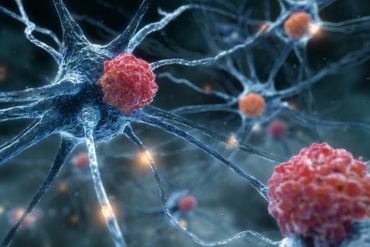Summary: Reducing activity in the anterior cingulate decreases empathetic responses in rats. The data suggests an observer shares the emotions of others as it enables them to prepare for danger.
Source: KNAW
Rats are amazing at avoiding dangers. What is their secret? Could empathy be a contributing factor? Or is this too far-fetched? This is what a group of researchers from the Netherlands Institute for Neuroscience tried to investigate. Their study, to be published on December 5th in PLoS Biology, shows that rats can use other rats as danger antennas, by being exquisitely sensitive to the emotions of the rats around them. With this finding, new targets for the treatment of empathy disorders in humans, such as psychopathy and frontotemporal dementia, will open in the future.
In contrast to the idea of empathy being a one-way street, where one person shares in the pain of another, the researchers discovered a more interactive process, in which animals align their emotions by mutual influences. They put two rats face to face, and then startled one of them (the demonstrator) with a brief electrical stimulation of the paws. They then observed the reaction of both rats. “The first thing you see is, upon witnessing its neighbor jump, the bystander suddenly looks scared as well. The bystander catches the fear of the demonstrator” says Rune Bruls, one of the two PhD students that performed the study. The reaction of the bystander influences how the demonstrator feels about the shock that happened to him. Bystanders that were less scared reduced the fear in their demonstrators. “Fear just jumps from one rat to another”, explains Bruls. “That way a rat can prepare for danger before they even see it.”
Neural similarity with humans
In humans, witnessing the pain of others activates a region between the two hemispheres that is also active when we feel pain in our own body. This is considered to be one of the core empathy regions in the brain. To see whether this region is the same in rats, the team injected a drug to temporarily reduce activity of this area. “What we observed, was striking: without the region that humans use to empathize, the rats were no longer sensitive to the distress of a fellow rat. Our sensitivity to the emotions of others is thus perhaps more similar to that of the rat than many may have thought” explains Professor Christian Keysers, the lead author of the study.
No nepotism
Another remarkable finding, is that empathy is independent from the fact whether you know the other. For rats that had never met each other, the emotions of the other rat were as contagious as for rats that had shared the same home for 5 weeks. “This really challenges our notions of the origin of empathy” says Valeria Gazzola, one of the senior authors of the study. Many believe that humans and animals are empathic, because if they are sensitive to the pains of their kids, it is good for Darwin fitness. This parental care then generalizes to empathizing with your closest friends. “What our data suggest, is that an observer shares the emotions of others because it enables the observer to prepare for danger. It’s not about helping the victim, but about avoiding to become a victim yourself” explains Gazzola.

It takes one to know one
Although familiarity with the demonstrator turns out not to play a role in whether a rat reacts empathic or not, previous experience does. Efe Soyman, a postdoc in the lab, compared two groups of observers: one that had, and one that hadn’t experienced electrical stimulation in the past. He found that while the experienced observers showed dramatic levels of empathic fear, the inexperienced ones barely reacted at all to what happened to the demonstrator. This is important, because it shows that emotional contagion is not an inborn mechanism, but something that we need to learn. “Rats are like humans: the more our experiences match those of the people we observe, the more we can empathize with what they feel. It takes one to know one!” Efe concludes.
Source:
KNAW
Media Contacts:
Christian Keysers – KNAW
Image Source:
The image is in the public domain.
Original Research: Open access
“Bidirectional cingulate-dependent danger information transfer across rats”. Yingying Han, Rune Bruls, Efe Soyman, Rajat Mani Thomas, Vasiliki Pentaraki, Naomi Jelinek, Mirjam Heinemans, Iege Bassez, Sam Verschooren, Illanah Pruis, Thijs Van Lierde, Nathaly Carrillo, Valeria Gazzola, Maria Carrillo, Christian Keysers.
PLOS Biology doi:10.1371/journal.pbio.3000524.
Abstract
Bidirectional cingulate-dependent danger information transfer across rats
Social transmission of freezing behavior has been conceived of as a one-way phenomenon in which an observer “catches” the fear of another. Here, we use a paradigm in which an observer rat witnesses another rat receiving electroshocks. Bayesian model comparison and Granger causality show that rats exchange information about danger in both directions: how the observer reacts to the demonstrator’s distress also influences how the demonstrator responds to the danger. This was true to a similar extent across highly familiar and entirely unfamiliar rats but is stronger in animals preexposed to shocks. Injecting muscimol in the anterior cingulate of observers reduced freezing in the observers and in the demonstrators receiving the shocks. Using simulations, we support the notion that the coupling of freezing across rats could be selected for to more efficiently detect dangers in a group, in a way similar to cross-species eavesdropping.







